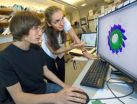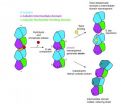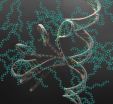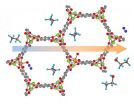(Press-News.org) A pathway to the design of even more effective versions of the powerful anti-cancer drug Taxol has been opened with the most detailed look ever at the assembly and disassembly of microtubules, tiny fibers of tubulin protein that form the cytoskeletons of living cells and play a crucial role in mitosis. Through a combination of high-resolution cryo-electron microscopy (cryo-EM) and new methodology for image analysis and structure interpretation, researchers with the Lawrence Berkeley National Laboratory (Berkeley Lab) and the University of California (UC) Berkeley have produced images of microtubule assembly and disassembly at the unprecedented resolution of 5 angstroms (Å). Among other insights, these observations provide the first explanation of Taxol's success as a cancer chemotherapy agent.
"This is the first experimental demonstration of the link between nucleotide state and tubulin conformation within the microtubules and, by extension, the relationship between tubulin conformation and the transition from assembled to disassembled microtubule structure," says Eva Nogales, a biophysicist with Berkeley Lab's Life Sciences Division who led this research. "We now have a clear understanding of how hydrolysis of guanosine triphosphate (GTP) leads to microtubule destabilization and how Taxol works to inhibit this activity."
Nogales, who is also a professor of biophysics and structural biology at UC Berkeley, as well as an investigator with the Howard Hughes Medical Institute, is the corresponding author of a paper describing this research in the journal Cell. The paper is entitled "High resolution αβ microtubule structures reveal the structural transitions in tubulin upon GTP hydrolysis." Co-authors are Gregory Alushin, Gabriel Lander, Elizabeth Kellogg, Rui Zhang and David Baker.
During mitosis, the process by which a dividing cell duplicates its chromosomes and distributes them between two daughter cells, microtubules disassemble and reform into spindles across which the duplicate sets of chromosomes migrate. For chromosome migration to occur, the microtubules attached to them must disassemble, carrying the chromosomes in the process. The crucial ability of microtubules to transition from a rigid polymerized or "assembled" state to a flexible depolymerized or "disassembled" state - called "dynamic instability" - is driven by GTP hydrolysis in the microtubule lattice. Taxol prevents or dramatically slows down the unchecked cell division that is cancer by binding to a microtubule in such a manner as to block the effects of hydrolysis. However, until now the atomic details as to how microtubules transition from polymerized to depolymerized structures and the role that Taxol can play have been sketchy.
"Uncovering the atomic details of the conformational cycle accompanying polymerization, nucleotide hydrolysis, and depolymerization is essential for a complete description of microtubule dynamics," Nogales says. "Such details should significantly aid in improving the potency and selectivity of existing anti-cancer drugs, as well as facilitate the development of novel agents."
To find these details, Nogales, an expert in electron microscopy and image analysis and a leading authority on the structure and dynamics of microtubules, employed cryo-EM, in which protein samples are flash-frozen at liquid nitrogen temperatures to preserve their natural structure. Using an FEI 300 kV Titan cryo-EM from the laboratory of Robert Glaeser, she and her colleagues generated cryo-EM reconstructions of tubulin proteins whose structures were either stabilized by GMPCPP, a GTP analogue, or were unstable and bound to guanosine diphosphate (GDP), or were bound to GDP but stabilized by the presence of Taxol.
The tubulin protein is a heterodimer consisting of alpha (α) and beta (β) monomer subunits. It features two guanine nucleotide binding sites, an "N-site" on the α-tubulin that is buried, and an "E-site" on the β-tubulin that is exposed when the tubulin is depolymerized. Previous microtubule reconstruction studies were unable to distinguish the highly similar α-tubulin and β-tubulin from each other.
"To be able to distinguish the α-tubulin from the β-tubulin, we had to resolve our images at better than 8 Å, which most prior cryo-EM studies were unable to do," Nogales says. "For that, we marked the subunits with kinesin, a protein motor that distinguishes between α- and β-tubulin."
Nogales and her colleagues found that GTP hydrolysis and the release of the phosphate (GTP becomes GDP) leads to a compaction of the E-site and a rearrangement of the α-tubulin monomer that generates a strain on the microtubule that destabilizes its structure. Taxol binding leads to a reversal of this E-site compaction and α-tubulin rearrangement that restores structural stabilization.
"Remarkably, Taxol binding globally reverses the majority of the conformational changes we observe when comparing the GMPCPP and GDP states," Nogales says. "We propose that GTP hydrolysis leads to conformational strain in the microtubule that would be released by bending during depolymerization. This model is consistent with the changes we observe upon taxol binding, which dramatically stabilizes the microtubule lattice. Our analysis supports a model in which microtubule-stabilizing agents like Taxol modulate conformational strain and longitudinal contacts in the microtubule lattice."
INFORMATION:
This research was supported by the National Institute of General Medical Sciences, the Damon Runyon Cancer Research Foundation, and the Howard Hughes Medical Institute.
Lawrence Berkeley National Laboratory addresses the world's most urgent scientific challenges by advancing sustainable energy, protecting human health, creating new materials, and revealing the origin and fate of the universe. Founded in 1931, Berkeley Lab's scientific expertise has been recognized with 13 Nobel prizes. The University of California manages Berkeley Lab for the U.S. Department of Energy's Office of Science. For more, visit http://www.lbl.gov.
New details on microtubules and how the anti-cancer drug Taxol works
Berkeley Lab researchers take an atomic-scale look at key cellular protein
2014-05-22
ELSE PRESS RELEASES FROM THIS DATE:
Which way is up?
2014-05-22
What do sled dogs and cell clusters have in common? According to research by UC Santa Barbara's Denise Montell, they both travel in groups and need a leader to make sure they all follow in the same direction.
Montell, Duggan Professor of Molecular Cellular and Developmental Biology, and colleagues worked on three independent projects involving E-cadherin, a protein found in epithelial cells throughout the body. The researchers used fruit-fly ovaries to uncover the role played by E-cadherin in collective cell migration. Their findings are reported today in the journal ...
Eumelanin's secrets
2014-05-22
CAMBRIDGE, Mass-- Melanin — and specifically, the form called eumelanin — is the primary pigment that gives humans the coloring of their skin, hair, and eyes. It protects the body from the hazards of ultraviolet and other radiation that can damage cells and lead to skin cancer, but the exact reason why the compound is so effective at blocking such a broad spectrum of sunlight has remained something of a mystery.
Now researchers at MIT and other institutions have solved that mystery, potentially opening the way for the development of synthetic materials that could have ...
US obesity epidemic making all segments of the nation fatter, study finds
2014-05-22
The nation's obesity epidemic is striking all groups of Americans, affecting those with more education and those with less education, as well as all ethnic groups, according to a new analysis that challenges prevailing assumptions about the reasons why the nation is getting heavier.
While some differences in weight are evident between groups based on race and education levels, all Americans have been getting fatter at about the same rate for the past 25 years, even as the nation saw increases in leisure time, increased availability of fruit and vegetables, and increases ...
Being Sardinian puts a smile on the face of the elderly
2014-05-22
Residents of the Italian island of Sardinia are known for their longevity. Now, a new study also shows that elderly Sardinians are less depressed and generally are in a better mental frame of mind than peers living elsewhere. The study, led by Maria Chiara Fastame and Maria Pietronilla Penna of the University of Cagliari in Italy and Paul Hitchcott from the Southampton Solent University in UK, is published in Springer's journal Applied Research in Quality of Life.
Various tests to measure the mental state and capacity of elderly people were performed on 191 cognitively ...
Gene therapy extends survival in an animal model of spinal muscular atrophy
2014-05-22
New Rochelle, NY, May 22, 2014—To make up for insufficient amounts of SMN protein, the cause of the inherited neuromuscular disease spinal muscular atrophy (SMA), researchers have successfully delivered a replacement SMN1 gene directly to the spinal cords of animal models of SMA. A new study demonstrating that enough copies of the SMN1 gene can be delivered to the spinal cord motor neurons to extend the survival of the treated animals is published in Human Gene Therapy, a peer-reviewed journal from Mary Ann Liebert, Inc., publishers. The article is available free on the ...
JILA study finds crowding has big effects on biomolecules
2014-05-22
Crowding has notoriously negative effects at large size scales, blamed for everything from human disease and depression to community resource shortages. But relatively little is known about the influence of crowding at the cellular level. A new JILA study shows that a crowded environment has dramatic effects on individual biomolecules.
In the first data on the underlying dynamics (or kinetics)of crowded single biomolecules , reported in Proceedings of the National Academy of Sciences,* JILA researchers found that crowding leads to a 35-fold increase in the folding rate ...
From separation to transformation: Metal-organic framework shows new talent
2014-05-22
This gift from science just keeps on giving. Measurements taken at the National Institute of Standards and Technology (NIST) show why a material already known to be good at separating components of natural gas also can do something trickier: help convert one chemical to another, a process called catalysis. The discovery is a rare example of a laboratory-made material easily performing a task that biology usually requires a complex series of steps to accomplish.
The material is a metal-organic framework (MOF), one of a class of substances whose porosity, high surface area ...
Don't blink! NIST studies why quantum dots suffer from 'fluorescence intermittency'
2014-05-22
Researchers at the National Institute of Standards and Technology (NIST), working in collaboration with the Naval Research Laboratory, have found that a particular species of quantum dots that weren't commonly thought to blink, do.
So what? Well, although the blinks are short—on the order of nanoseconds to milliseconds—even brief fluctuations can result in efficiency losses that could cause trouble for using quantum dots to generate photons that move information around inside a quantum computer or between nodes of a future high-security internet based on quantum telecommunications.
Beyond ...
Putting a number on opinion dynamics in a population
2014-05-22
Philadelphia, PA—Opinion formation in a large population is influenced by both endogenous factors, such as interaction with one's peers—in-person and via social media—as well as exogenous factors, such as the media, of which mainstream media is one of the most influential factors. For example, according to a study conducted by the National Bureau of Economic Research in 2006, after the introduction and expansion of Fox News in the United States between 1996 and 2000, an estimated 3-28% of the audience was persuaded to vote Republican.
In a recent paper published in ...
NIST chip produces and detects specialized gas for biomedical analysis
2014-05-22
A chip-scale device that both produces and detects a specialized gas used in biomedical analysis and medical imaging has been built and demonstrated at the National Institute of Standards and Technology (NIST). Described in Nature Communications,* the new microfluidic chip produces polarized (or magnetized) xenon gas and then detects even the faintest magnetic signals from the gas.
Polarized xenon—with the atoms' nuclear "spins" aligned like bar magnets in the same direction—can be dissolved in liquids and used to detect the presence of certain molecules. A chemical interaction ...
LAST 30 PRESS RELEASES:
The Ceramic Society of Japan’s Oxoate Ceramics Research Association launches new international book project
Heart-brain connection: international study reveals the role of the vagus nerve in keeping the heart young
Researchers identify Rb1 as a predictive biomarker for a new therapeutic strategy in some breast cancers
Survey reveals ethical gaps slowing AI adoption in pediatric surgery
Stimulant ADHD medications work differently than thought
AI overestimates how smart people are, according to HSE economists
HSE researchers create genome-wide map of quadruplexes
Scientists boost cell "powerhouses" to burn more calories
Automatic label checking: The missing step in making reliable medical AI
Low daily alcohol intake linked to 50% heightened mouth cancer risk in India
American Meteorological Society announces Rick Spinrad as 2026 President-Elect
Biomass-based carbon capture spotlighted in newly released global climate webinar recording
Illuminating invisible nano pollutants: advanced bioimaging tracks the full journey of emerging nanoscale contaminants in living systems
How does age affect recovery from spinal cord injury?
Novel AI tool offers prognosis for patients with head and neck cancer
Fathers’ microplastic exposure tied to their children’s metabolic problems
Research validates laboratory model for studying high-grade serous ovarian cancer
SIR 2026 delivers transformative breakthroughs in minimally invasive medicine to improve patient care
Stem Cell Reports most downloaded papers of 2025 highlight the breadth and impact of stem cell research
Oxford-led study estimates NHS spends around 3% of its primary and secondary care budget on the health impacts of heat and cold in England
A researcher’s long quest leads to a smart composite breakthrough
Urban wild bees act as “microbial sensors” of city health.
New study finds where you live affects recovery after a hip fracture
Forecasting the impact of fully automated vehicle adoption on US road traffic injuries
Alcohol-related hospitalizations from 2016 to 2022
Semaglutide and hospitalizations in patients with obesity and established cardiovascular disease
Researchers ‘listen in’ to embryo-mother interactions during implantation using a culture system replicating the womb lining
How changing your diet could help save the world
How to make AI truly scalable and reliable for real-time traffic assignment?
Beyond fragmented markets: A new framework for efficient and stable ride-pooling
[Press-News.org] New details on microtubules and how the anti-cancer drug Taxol worksBerkeley Lab researchers take an atomic-scale look at key cellular protein







